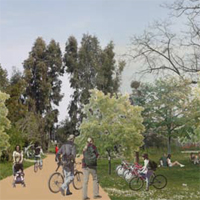Riding in Marmilla On the Old Railway’s Trail
DOI:
https://doi.org/10.6092/1970-9870/234Keywords:
greenway, pista ciclabile, sostenibilità, mobilità leggera, risorse locali, economia della conoscenzaAbstract
The project re-discovers a stretch of disused track of Sardinia’s complementary railway and re-uses it as a cycle lane: a greenway surrounded by the landscapes of Marmilla (Medio Campidano Province, Sardinia) that is both a tourist route and a network for an alternative mobility that connects seven villages in the territory.
The fact that only cyclists and walkers can go through this route makes this essentially an alternative means to explore the area, with the aim of creating a new way to represent the Island, not only for visitors but for the inhabitants themselves.
The old stations and the signal boxes still present along the green artery can be recovered as access/refreshment/information nodes of the network.
In particular the stations, still in good conditions, can be employed as rest-stops, information-points and small showrooms for temporary or permanent exhibitions, in which local artists display their handcrafts. In the stations equipped with other service building in the immediate vicinity, small guesthouses that can accommodate the short-stay tourists have also been planned.
On the other hand, the strong degradation where the signal boxes are only allows the recovery of this places as heritage sites where the ruins remain silent witnesses, telling travelers about local life long gone.
These points have been provided with parking areas equipped with street furniture (seating systems, fountains, bicycle racks, etc.), Mediterranean scrub and appropriate information systems through which visitors can obtain information on the bike path and the secondary ramifications directed to the attractions in the surroundings.
The whole area, in fact, is rich with sites of great value (Nuragic architecture, medieval buildings, disused mines, places of worship, etc.) therefore the cycle-lane would be the main vector for travelers to access the numerous secondary naturalistic, historical, architectural and also gastronomic pathways that distinguish the surrounding area.
In this way the cultural and natural resources of the area would be more accessible to visitors and, at the same time, it would strengthen the bond between the inhabitants and places. The project is part of an alternative vision of development that passes through the valorization of the local resources such as traditional agriculture products, the artistic crafts, cultural and natural tourism and small business, supported by local knowledge deeply rooted in the territory. So the project wants not only to cherish the memory of places, but also to reinterpret their signs as potential components of productivity in the future. Becoming aware of their own peculiar and intriguing culture and understanding this territory, residents first and travelers after will feel the need to protect and promote this charming region.
Downloads
References
AA.VV. (2003) “Velocità Controllate”, Lotus Navigator n°8.
ARUP (2008) Drivers of Change, Prestel Edition.
Atzori G., Sanna G. (1996) “Omines”, Edizioni Castello, Cagliari.
Banco di Sardegna (1993) “Architettura romanica dalla metà del mille al primo ‘300”, Ilisso edizioni, Nuoro.
Bertani C. (2003) "Energia, natura e civiltà. Un futuro possibile?", Giunti Ed., Firenze.
Boi A., Zanderighi L. (2008) “Prodotti tipici e turismo”, Sardegna Ricerche, Egea, Milano.
Botta M., Crepet P., con Zois G. (2007) “Dove abitano le emozioni”, Einaudi, Torino.
Botticini R. (1991) “GEO Sardegna”, Sole edizioni, Cagliari.
Butera F. (2001) “Energia e sviluppo urbano sostenibile”, Archivio di Studi Urbani e Rurali n°71-72.
Calamandrei P. (1951) “Sardegna”, Il ponte - Rivista mensile di politica e letteratura, La Nuova Italia editrice, Firenze.
Camagni R., Gibelli M.C., Rigamonti P. (2002) “Urban mobility and urban form: the social and environmental costs of different patterns of urban expansion”, Ecological Economics n° 40, special section: economics of urban sustainability. Available in: www.elsevier.com/locate/ecolecon.
Caocci A. (1988) “La Sardegna”, Mursia editore, Milano.
Caravaggi L. (2002) “Paesaggi di paesaggi”, Meltemi Ed., Roma.
Casula F. C. (1995) “La Carta de Logu del Regno di Arborea”, Carlo Delfino Editore, Sassari.
CCE (2007), Libro Verde. Verso una nuova cultura della mobilità urbana, Bruxelles.
De Pascali P. (2008) "Città ed energia. La valenza energetica dell'organizzazione insediativa", Franco Angeli, Milano.
Droege P.(2008) “La città rinnovabile. Guida completa ad una rivoluzione urbana”, Edizioni Ambiente, Città di Castello (PG).
Foray D. (2006) “L’economia della conoscenza”, Il Mulino, Bologna.
Lilliu G. (1996) “Sardegna nuragica”, Istituto Geografico De Agostini, Novara.
Lima A. I. (a cura di) (2010) “Per un’architettura come ecologia umana, studiosi a confronto”, Jaca Book, Milano.
Magnaghi A. (1998) “Il territorio degli abitanti”, Dunod, Milano.
Magnaghi A. (2000) “Il progetto locale”, Bollati Boringhieri, Torino.
Migaleddu V.(2005), Sviluppo Sostenibile In Sardegna, WWF Onlus sezione Gallura, Sassari.
Piras A., Sanna A. (2006) “La Marmilla”, aipsa edizioni, Cagliari.
Poggio A., Berrini M. (2010) “Green life. Guida alla vita nelle città di domani”, Ed. Ambiente, Milano.
Regione Autonoma della Sardegna (2006), Piani Energetico e Ambientale della Regione Sardegna (PEARS).
Rifkin J. (2006) “L’energia rinnovabile e la rivoluzione architettonica del XXI secolo”; in Rassegna n°85.
Rullani E. (2004) “L’economia della conoscenza. Creatività e valore nel capitalismo delle reti”, Carocci, Roma.
Rullani E. (2004) “La fabbrica dell’immateriale. Produrre valore con la conoscenza”, Carocci, Roma.
Sassu A. (2004) “Saperi locali in Sardegna: tradizione e innovazione nell’attività economica”, CUEC, Cagliari.
Toccolini A., Fumagalli N., Senes G. (2004) “Progettare i percorsi verdi”, Maggioli Editore, Santarcangelo di Romagna (RN).
Toccolini A. (2005) “Piano e progetto di area verde”, Maggioli Editore, Santarcangelo di Romagna (RN).
Ventura F. (2009) “eco-compatibilità del progetto”, in Eco-sostenibilità del progetto. Dalle caratteristiche proprie dei luoghi, dei criteri insediativi, dei materiali e i loro metodi d’impiego fino all’uso di tecniche e tecnologie avanzate, Area n°106.
Zervos C. (1981) “La civiltà della Sardegna”, Libreria Scientifica Internazionale, Sassari.
Yeang K. (2009) “ECOmasterplanning”, J. Wiley & Sons.

Downloads
Published
How to Cite
Issue
Section
License


